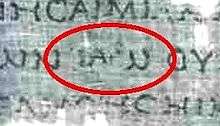4Q120


The manuscript 4Q120 (also pap4QLXXLevb) is a Septuagint manuscript (LXX) of the biblical Book of Leviticus. The Rahlfs-No. is 802. Palaoegraphycally is dating from the first century BCE. Currently the manuscript is housed in the Rockefeller Museum in Jerusalem.
This scroll is in a very fragmented condition. Today it consists of 97 fragments. However, only 31 of those fragments can be reasonably reconstructed and deciphered, allowing for a reading of Leviticus 1.11 through 5.25; the remaining fragments are too small to allow for reliable identification. In addition to smaller text-critical variants, the manuscript displays the divine name in Greek characters, as ΙΑΩ (the trigrammaton) in Leviticus 3:12 (frg. 6) and 4:27 (frg. 20), instead of later practise of replacing it with κύριος ("Lord"). Skehan suggest that the reading IAW is more original than Kurios.[1] Emmanel To claims the use of IAW as proof that the "papyrus represents an early version of the greek scripture..." antedating the text of the main manuscripts of Septuagint LXX.[2] IAO can be seen a transliteration of YAHO. The Codex Marchalianus is the only other extant manuscript of the Septaugint that uses ΙΑΩ to transcribe the tetragrammaton.[3] Scriptio continua is used throughout.
Additionally, space bands are occasionally used for the separation of concepts, and divisions within the text. A special sign (⌐) for separation of paragraphs is found fragment 27, between the lines 6 and 7. While the later divisions would label these verses 5:20-26, it appears to testify to a classical transition from chapter 5 to 6.
References
- ↑ Skehan, Patrick W. (1957). The Qumran Manuscripts and Textual Criticism,: Volume du congrès, Strasbourg 1956. Supplements to Vetus Testamentum 4. Leiden: Brill Publishers. pp. 148–160.
- ↑ Sabine Bieberstein, Kornélia Buday, Ursula Rapp (2006). Brücken Bauen in Einem Vielgestaltigen Europa. volume 14 de Jahrbuch der Europäischen Gesellschaft für Theologische Forschung von Frauen: European Society of Women in Theological Research, Jahrbuch der Europäischen Gesellschaft für die Theologische Forschung von Frauen, European Society of Women in Theological Research, Journal of the European Society of Women in Theological Research. Peeters Publishers. p. 60. ISBN 9042918950.
- ↑ David Edward Aune (2006). Apocalypticism, Prophecy and Magic in Early Christianity: Collected Essays. Mohr Siebeck. p. 363. ISBN 3-16-149020-7.
Bibliography
- Skehan, Patrick W. (1957). The Qumran Manuscripts and Textual Criticism,: Volume du congrès, Strasbourg 1956. Supplements to Vetus Testamentum 4. Leiden: Brill Publishers. pp. 148–160.
- Ulrich, Eugene (1992). 120. pap4QLXXLeviticusb in: Discoveries in the Judean Desert: IX. Qumran Cave 4. IV. Oxford: Clarendon Press. pp. 167–186,. ISBN 0-19-826328-7.
- Ulrich, Eugene (1992). by George J. Brooke and Barnabas Lindars. SBL Septuagint and Cognate Studies Series 33, eds. The Septuagint Manuscripts from Qumran: A Reappraisal of Their Value, in: Septuagint, Scrolls, and Cognate Writings. Atlanta: Scholars Press. pp. 49–80.